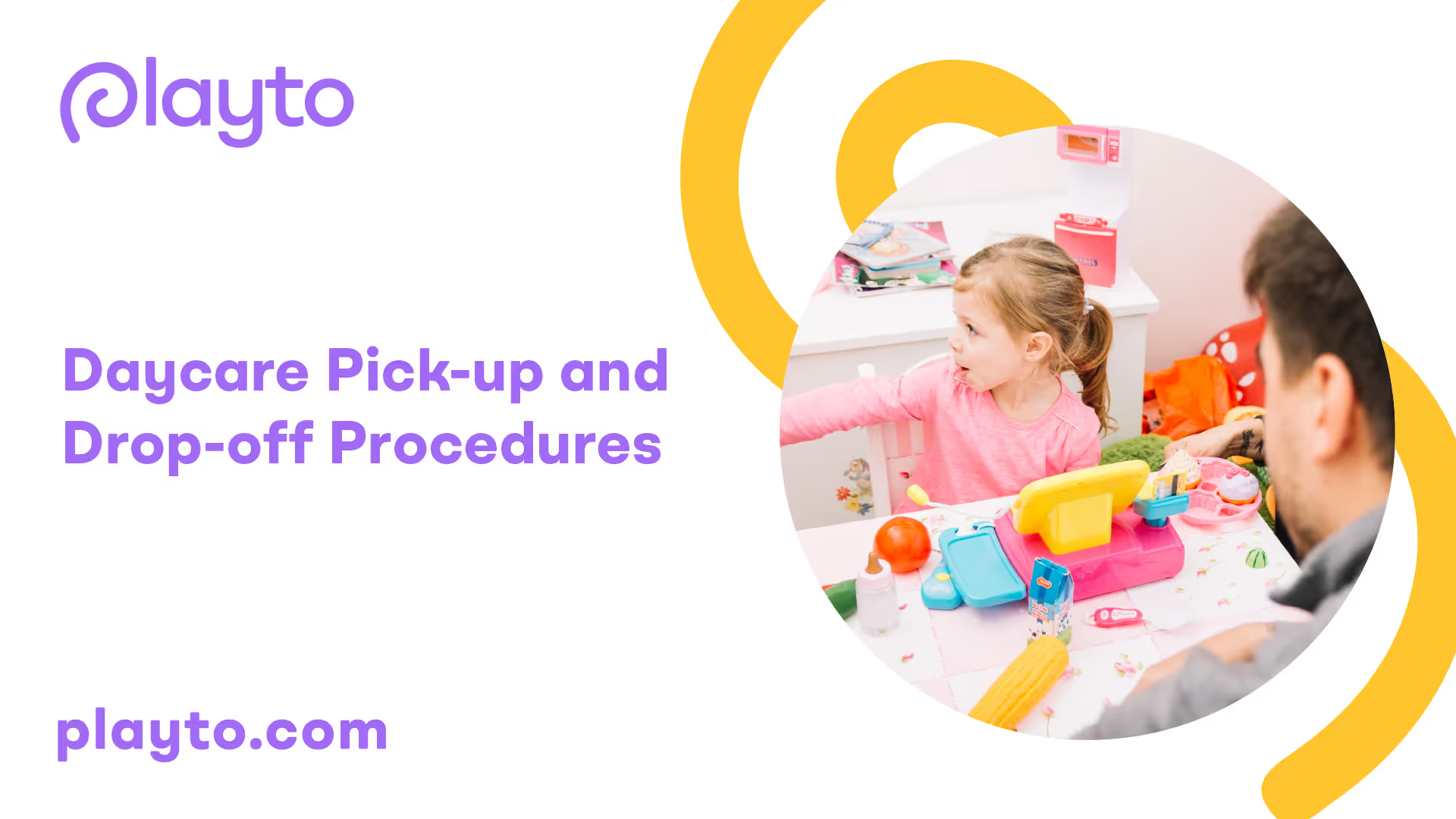Drop-Off and Pick-Up Procedures
When it comes to daycare, drop-off and pick-up procedures play a vital role in ensuring the safety and well-being of children. Establishing clear guidelines and protocols helps to streamline the process and maintain a secure environment. In this section, we will discuss the standard operating hours and identification requirements commonly observed in daycare facilities.

Standard Operating Hours
Daycare drop-off and pick-up times may vary depending on the facility and the needs of the parents or guardians. In some cases, drop-off times can range from around 7:00 am to 7:30 am, while pick-up times may fall between 4:00 pm to 5:30 pm. However, it's important to note that these hours can differ based on the daycare's specific policies and the family's work schedules.
It is crucial for parents or guardians to familiarize themselves with the daycare's operating hours to ensure they are able to drop off and pick up their child within the designated time frame. Timely drop-off and pick-up not only help daycare staff manage their responsibilities effectively but also ensure a smooth transition for the children.
Identification Requirements
To maintain a secure and controlled environment, most daycare facilities require parents or guardians to present valid picture identification when dropping off or picking up their child. This measure helps to ensure the safety of the children and confirms that the right person is collecting the child [2].
When arriving at the daycare facility, parents or guardians should be prepared to provide their identification, such as a driver's license or government-issued identification card. Daycare staff will verify the identity of the person by cross-checking the information on the identification document with the child's authorized individuals list. This process helps to prevent unauthorized individuals from gaining access to the children.
By adhering to the identification requirements, daycare facilities ensure that children are released only to authorized individuals, promoting the overall safety and well-being of the children in their care. It is recommended that parents or guardians inquire about the specific identification requirements of the daycare they are enrolled in to ensure compliance.
Maintaining a well-structured drop-off and pick-up system with clear operating hours and identification requirements helps daycare facilities operate smoothly and ensures the safety of the children. By following these procedures, parents can have peace of mind knowing that their child is in a secure and nurturing environment. To learn more about daycare policies and safety measures, explore our articles on daycare policies on sunscreen and outdoor safety and teaching basic safety skills in daycare.
Sign-In/Out Protocols
Ensuring the safety and security of children in daycare centers requires well-defined sign-in/out protocols. These protocols serve two essential purposes: tracking attendance and implementing safety measures.

Tracking Attendance
Daycare centers often require parents to sign in and out when picking up and dropping off their children. This practice allows the center to keep a record of who picks up and drops off the children at any given time.
By tracking attendance, daycare centers can maintain accurate records, ensuring that all children are accounted for at all times. This information is crucial for emergency situations or if a child's whereabouts need to be determined. It also helps staff members monitor the number of children present and plan activities accordingly.
Safety Measures
Apart from tracking attendance, sign-in/out protocols contribute to the overall safety of the daycare environment. They serve as a security measure, ensuring that only authorized individuals have access to the children.
Parents or authorized guardians are typically required to provide identification during the sign-in/out process. This can include showing a driver's license, ID card, or any other form of identification to verify their identity. By implementing identification requirements, daycare centers can confirm that children are being released to the right individuals, thereby minimizing the risk of unauthorized access.
Moreover, sign-in/out protocols also help daycare centers adhere to specific pick-up and drop-off times. Many centers have designated times for these procedures to ensure that children are not left unattended for extended periods of time. This helps maintain a safe and structured environment for the children's well-being.
To further enhance safety and efficiency, daycare centers can explore digital solutions that implement contactless check-in/out procedures. Childcare management solutions can automate attendance for both staff and children, eliminate manual data entry errors, and maintain social distancing protocols. Such solutions can streamline the sign-in/out process, providing a more efficient experience for parents and staff.
In addition to sign-in/out protocols, daycare centers can implement security enhancements, such as background checks for staff members and the use of dismissal management systems like Raptor DismissalSafe. These systems enhance the efficiency and safety of the dismissal process by facilitating parent communications, providing real-time information, and managing transportation logistics. By combining these measures, daycare centers can create a secure environment for children and provide peace of mind to parents and guardians.
By implementing robust sign-in/out protocols, daycare centers prioritize the safety and security of the children in their care. These protocols not only track attendance but also contribute to maintaining a structured and controlled environment that ensures the well-being of every child.
Transportation Guidelines
Ensuring the safety and well-being of children during daycare pick-up and drop-off is of utmost importance. Daycare centers often have specific transportation guidelines in place to maintain the safety and security of children. In this section, we will explore two key aspects of transportation guidelines: car seat regulations and COVID-19 protocols.

Car Seat Regulations
Daycare centers may require children to be placed in a car seat or booster seat when transported in a vehicle to ensure their safety and that they are securely strapped in. Car seat regulations may vary depending on the age and size of the child, as well as local regulations. It is essential for parents to be aware of these regulations and comply with them when dropping off or picking up their child.
To help parents understand the specific car seat requirements, daycare centers should provide clear guidelines and resources. This may include information on the appropriate type of car seat based on the child's age, height, and weight. By following these regulations, parents can ensure the safety of their child during transportation to and from the daycare center.
COVID-19 Protocols
During the ongoing COVID-19 pandemic, daycare facilities have implemented specific protocols to prioritize the health and safety of children and staff. These protocols may include guidelines recommended by the Centers for Disease Control and Prevention (CDC), such as wearing masks, practicing social distancing, and following contactless drop-off procedures [2].
Daycare centers should clearly communicate these protocols to parents and ensure their understanding and compliance. This may involve providing information on the use of face masks, hand hygiene practices, temperature checks, and any specific entry procedures. By adhering to these COVID-19 protocols, daycare centers can help minimize the risk of transmission and create a safe environment for children and staff.
It is crucial for parents to stay informed about any changes in transportation guidelines and COVID-19 protocols implemented by the daycare center. Regular communication between parents and daycare staff can help address any concerns or questions regarding transportation procedures and ensure that everyone is working together to prioritize the safety and well-being of the children.
In addition to transportation guidelines, daycare centers also implement various other daycare policies on safety to create a secure and nurturing environment for children. Teaching basic safety skills in daycare can further empower children to understand and practice safety measures.
Efficiency Strategies
To streamline daycare pick-up and drop-off procedures, implementing efficient strategies can significantly improve the overall process. Two key strategies that can enhance efficiency are staggered timings and hygiene stations.
Staggered Timings
Many daycare centers have specific times for dropping off and picking up children to ensure that the children are not left unattended for long periods. Staggering these timings can help reduce the number of parents arriving during high-volume times of the day, avoiding long lines and backups.
By assigning different time slots for drop-off and pick-up, parents can be encouraged to arrive at staggered intervals, decreasing congestion and allowing for a smoother flow of traffic. This approach also provides an opportunity for verbal health screens, temperature checks, and walking children into the center without causing overcrowding or delays. It ensures that each child receives the necessary attention and care upon arrival and departure.
Hygiene Stations
Maintaining proper hygiene is crucial for the well-being of children in daycare settings. Setting up hygiene stations at the entry of childcare centers can help ensure that children have clean hands before entering the building, reducing the germ load significantly and teaching proper handwashing techniques.
Hygiene stations typically include hand sanitizing stations or sinks equipped with soap dispensers, paper towels, and instructional signage on proper handwashing techniques. By making these stations easily accessible and visible at the entry points, parents and children can practice good hand hygiene before entering the daycare facility. This measure not only helps reduce the spread of germs but also instills important habits that promote overall health and well-being.
By implementing staggered timings and establishing hygiene stations, daycare centers can enhance efficiency and promote a smoother pick-up and drop-off process. These strategies not only improve the overall experience for parents and children but also contribute to the safety and well-being of everyone in the daycare environment. For more information on daycare policies and safety, check out our articles on daycare policies on sunscreen and outdoor safety and teaching basic safety skills in daycare.
Contactless Procedures
In today's fast-paced world, daycare centers are adopting innovative strategies to streamline their drop-off and pick-up procedures while ensuring the safety and convenience of children and parents. Contactless procedures, such as digital solutions and QR code integration, have emerged as effective methods for improving efficiency and reducing physical contact.
Digital Solutions
Implementing digital solutions for check-in and out procedures in childcare centers can bring numerous benefits. These solutions automate attendance for both staff and children, eliminating manual data entry errors and saving time for everyone involved. Additionally, digital solutions help maintain social distancing protocols, reducing the risk of transmission.
By using a childcare management solution like EZChildTrack, centers can implement contactless check-in and out procedures. This solution provides multiple contactless processes, such as using wireless scanners or smartphone cameras to read QR codes from parents' smartphones. Parents can receive their unique QR codes through email blasts, simplifying the setup process. With this digital solution, daycare centers can automate administrative tasks, improve efficiency, and enhance the overall experience for parents and children.
QR Code Integration
QR code integration is a key component of contactless procedures in daycare centers. QR codes can be generated for each child and parent to facilitate smooth and efficient drop-off and pick-up processes. Parents can simply present their QR codes at designated scanning stations, allowing staff to quickly record attendance and verify authorized pickups.
QR codes provide a secure and reliable way to identify parents and authorized individuals. They can be easily generated and accessed through smartphone apps or email, making them a convenient and accessible solution for parents. By leveraging QR code integration, daycare centers can enhance security, improve efficiency, and minimize physical contact during drop-off and pick-up procedures.
Implementing contactless procedures through digital solutions and QR code integration is a proactive approach to adapt to the changing needs of daycare centers and parents. These strategies not only enhance efficiency but also prioritize the safety and well-being of children and staff. By embracing technology, daycare centers can create a seamless and secure environment for parents and children, ensuring a positive experience for all involved.
Security Enhancements
Ensuring the safety and security of children in daycare is of utmost importance. Daycare centers implement various security enhancements to maintain a secure environment. Two key aspects of these security enhancements are background checks and dismissal management.
Background Checks
To maintain a safe environment, daycare centers conduct background checks on staff members and volunteers. Background checks help identify any criminal history or potential risks associated with individuals working in close proximity to children. By integrating criminal background checks into the hiring and volunteer application process, daycare centers can ensure that each person's presence aligns with the highest safety standards [4].
Background checks typically involve screening for criminal records, including offenses related to child abuse or neglect. By conducting thorough background checks, daycare centers can provide parents with peace of mind, knowing that their children are in the care of trusted individuals.
Dismissal Management
Dismissal management is another crucial aspect of daycare security. Proper dismissal procedures ensure that children are released only to authorized individuals. Daycare centers establish clear protocols to verify the identity of those picking up children and to prevent unauthorized access.
Photo identification is often required during the dismissal process. Parents or authorized individuals may need to present identification that matches the information provided during enrollment. This helps confirm their identity and ensures that children are released to the right person.
Additionally, some daycare centers use digital systems to streamline the dismissal process. These systems may include electronic sign-out sheets, which allow parents or authorized individuals to digitally confirm the pickup of their child. This helps maintain accurate records and provides an additional layer of security.
By implementing thorough background checks and efficient dismissal management procedures, daycare centers create a secure environment for children. These security enhancements work in tandem with other daycare policies on safety, such as teaching basic safety skills and maintaining appropriate ratios of caregivers to children. It is essential for daycare centers to prioritize the safety and well-being of every child in their care.
